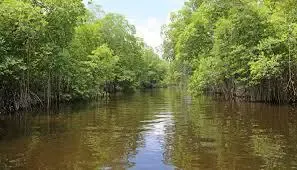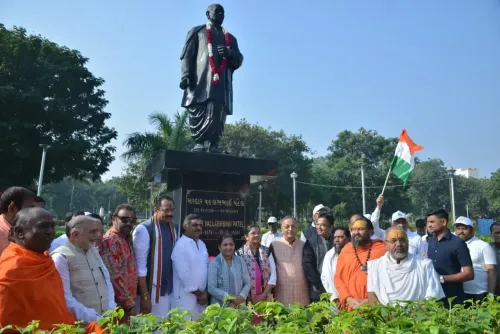Is the TN government taking bold steps to restore Ennore Creek's mangroves?

Synopsis
Key Takeaways
- 20,000 mangrove saplings are being planted.
- The project utilizes the innovative fishbone model for restoration.
- Over one lakh additional saplings are being raised for future planting.
- Approximately 250 hectares of invasive species have been removed.
- This initiative aims to support local fishing communities.
Chennai, Nov 17 (NationPress) The once heavily polluted Ennore Creek in Chennai, which suffered from industrial waste and an oil spill, is beginning to show signs of ecological recovery due to a significant mangrove restoration initiative.
The Forest Department has embarked on a mission to plant 20,000 mangrove saplings across the estuary utilizing an innovative approach called the “fishbone” restoration model, which is one of the most substantial restoration efforts in recent times.
This initiative encompasses 15 hectares of land, including four hectares developed using the fishbone technique, which involves creating narrow tidal channels that enable seawater to flow into the restoration area during high tides.
The enhanced circulation of water fosters favorable conditions for mangrove growth by maintaining stable salinity and moisture.
This year's activities build upon last season’s extensive plantation drive, wherein 1.8 lakh mangrove saplings of essential species were planted.
In a bid to bolster biodiversity, the mix of species has been diversified, aiming to enhance ecological resilience and habitat strength.
The creek's continuous water supply is anticipated to ensure high survival rates for the newly planted saplings. Over one lakh additional mangrove saplings are currently being nurtured, set to be planted by January, further solidifying the long-term restoration strategy.
To facilitate new plantings and encourage natural regeneration, approximately 250 hectares of invasive Prosopis juliflora have been cleared from the creek area.
The eradication of this aggressive species has liberated essential habitats that were previously overwhelmed by dense, water-consuming growth. A central nursery established in Kattuppalli village has successfully produced over one lakh saplings for the current planting season, forming the backbone of the department’s initiative to restore the creek's ecological integrity.
The restoration process is expected to span at least two years for the saplings to take root. As the mangroves mature, the revitalized habitat will gradually support the growth of algae and zooplankton, attracting various fish and prawn species.
This ecological revitalization is projected to benefit local fishing communities by enhancing catch potential and providing new livelihood opportunities.
The restored mangrove environment will also create new feeding, nesting, and roosting sites for both resident and migratory birds, transforming Ennore Creek back into a dynamic coastal ecosystem.









